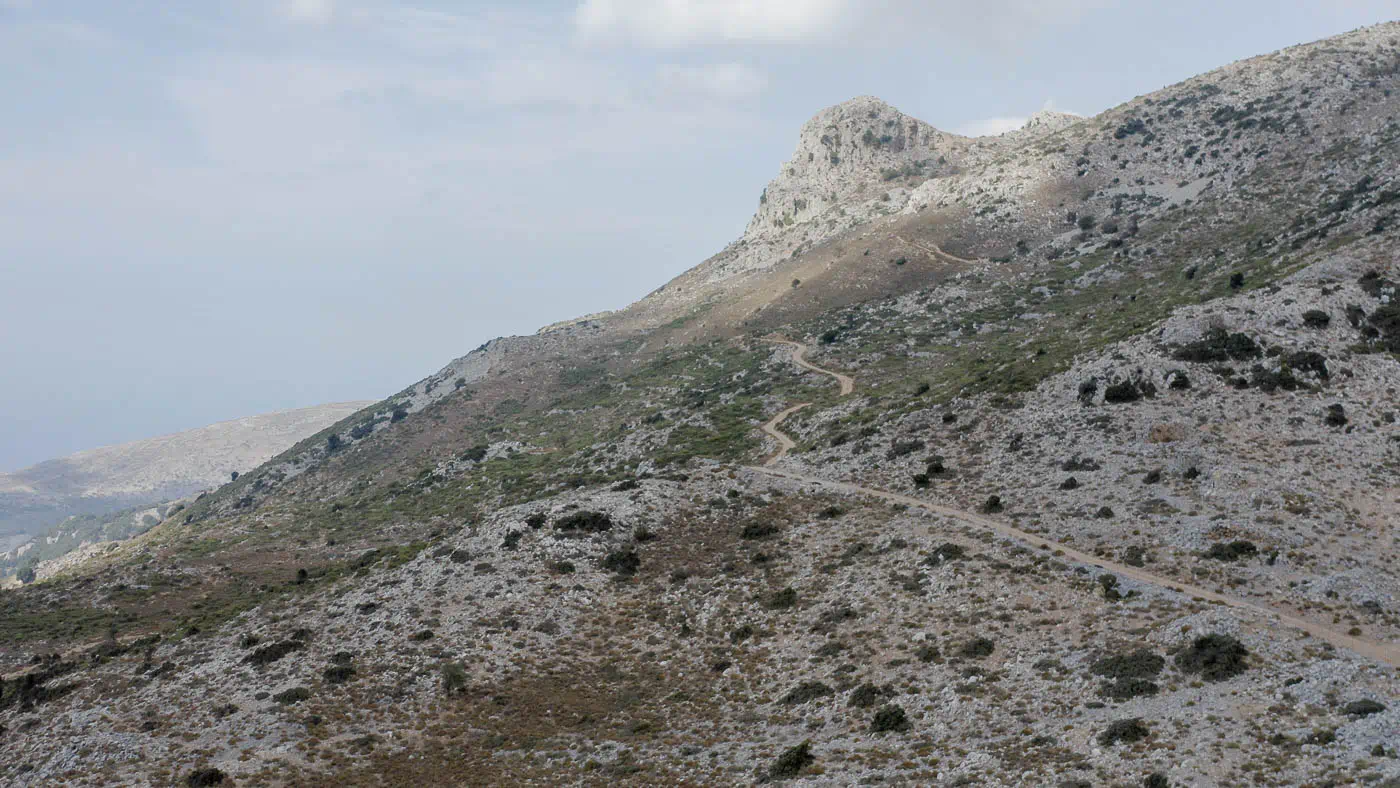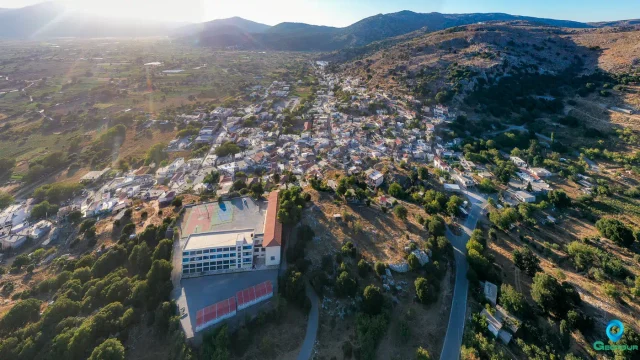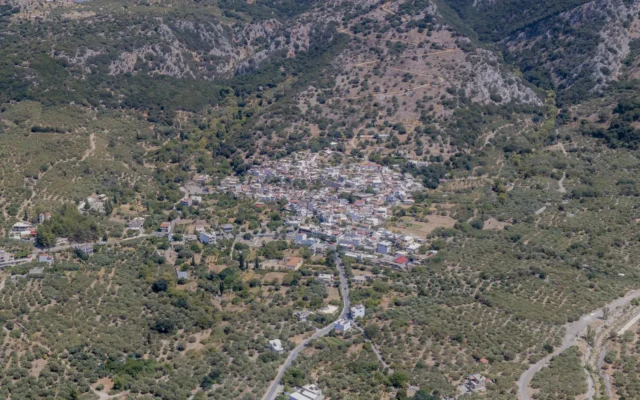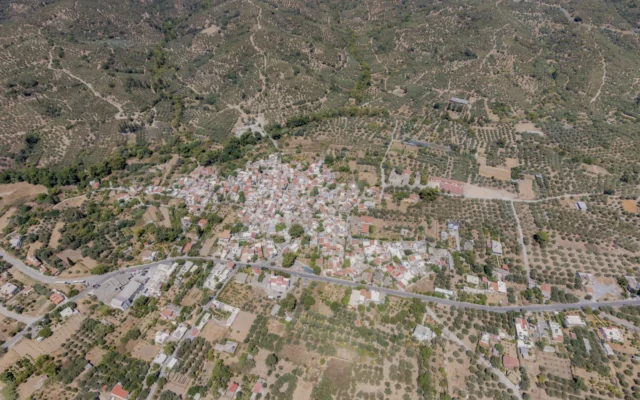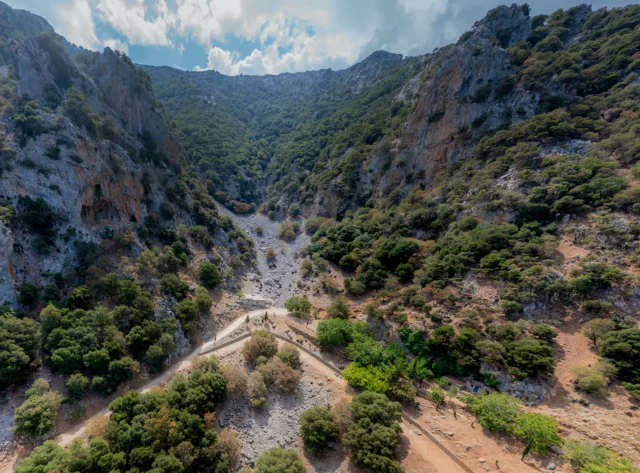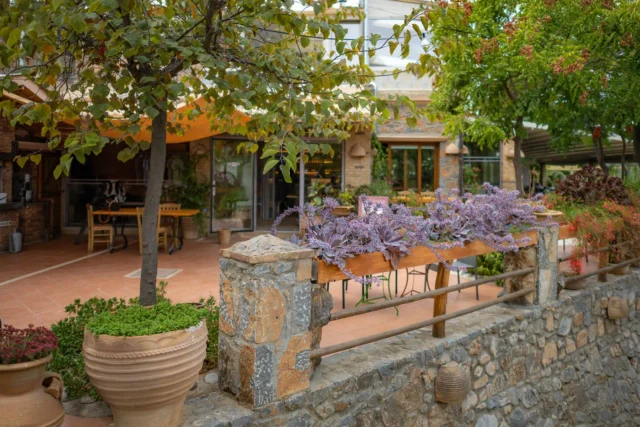Situated in the northern Lasithi mountains, the Karphi overlooks the southern slopes of the Dikti massif.
Karphi is recognized as one of the largest and most extensively excavated defensible settlements dating to the Late Minoan IIIC and Subminoan periods (circa 1200–970 BCE). It is considered a type site for this era in Crete. Initially interpreted as a refuge site, modern scholarship views its establishment as a more gradual process spanning several generations, coinciding with broader settlement shifts at the end of the Bronze Age.
[bt_bb_video bb_version=”4.9.1″ video=”https://www.youtube.com/watch?v=M6hZR1gSxrI” aspect_ratio=”” disable_controls=”no” loop_video=”” responsive=”” publish_datetime=”” expiry_datetime=”” animation=”no_animation” el_id=”” el_class=”” el_style=””][/bt_bb_video]
Historical Periods and Key Events
Delving deeper into the timeline of Karphi reveals its intricate connection to the tumultuous end of the Bronze Age and the dawn of the Early Iron Age in Crete and the wider Eastern Mediterranean. The site’s history, spanning the Late Minoan IIIB/C Transition through the Subminoan period before its eventual abandonment in the Protogeometric, offers a valuable lens through which to understand the societal upheavals, adaptations, and transformations of this pivotal era.
Late Minoan IIIB/C Transition and Early LM IIIC (circa 1220/10-1190 BCE)
The emergence of Karphi is inextricably linked to the widespread crisis that engulfed the Eastern Mediterranean towards the end of the 13th century BCE. This period, often characterized by the collapse of established political and economic systems, witnessed significant population movements and a heightened concern for security. In Crete, this manifested as a dramatic shift in settlement patterns, with a notable trend towards the abandonment of low-lying, easily accessible villages in favor of naturally defensible locations, typically on hilltops and mountainous terrain. Karphi, situated high in the northern Lasithi mountains, perfectly embodies this phenomenon.
The precise dating of Karphi’s foundation remains a subject of nuanced scholarly discussion. While it is generally agreed that the site came into being during the transition from the Late Minoan IIIB to the Late Minoan IIIC period (roughly the late 13th century BCE), some scholars propose that occupation may have commenced slightly later, within the early phases of LM IIIC. This transitional phase, spanning approximately the last few decades of the 13th century BCE and the very beginning of the 12th century BCE (circa 1220/10-1190 BCE), was a time of significant instability. The breakdown of the Mycenaean political security system in the Aegean created a vacuum that likely fostered increased instances of warfare, invasion, piracy, and raiding. The construction of a new settlement in such a remote and defensible location as Karphi strongly suggests a direct response to these mounting security concerns. People were seeking refuge from the perceived threats, indicating a profound lack of confidence in the previous social and political order.
This period also witnessed a broader pattern of abandonment and destruction across Crete, although the chronology of these events was not uniformly synchronized across different regions and former administrative centers. Only the most robust centers like Knossos and Chania managed to maintain a degree of continuity. The establishment of Karphi, along with other similar ‘defensible sites’, should be viewed within this context of widespread disruption and the need for communities to ensure their own safety in the absence of a centralized protective power.
LM IIIC and Subminoan (circa 1200-970 BC)
The Late Minoan IIIC and Subminoan periods represent the zenith of Karphi’s existence, spanning roughly from 1200 to 970 BC. During this time, Karphi grew to become one of the largest and most significant settlements of its kind in Crete. While often referred to as a ‘refuge site,’ modern archaeological understanding suggests that its establishment was not necessarily a single, panicked flight, but rather a more protracted process of relocation and community formation that may have unfolded over several generations.
Life at Karphi during these centuries was characterized by the adaptation to a new environment and the development of a distinct social and possibly political identity within the context of its isolation. The architectural remains reveal a densely packed settlement, indicating a substantial population. The discovery of specific structures like the so-called “temple” and “Great House” hints at the development of unique cultural and potentially religious practices within the community. The presence of “religious” objects, including cylindrical anthropomorphic figures and “snake tubes,” suggests ritual activities that were central to the lives of Karphi’s inhabitants. The fact that similar assemblages are found at other contemporary sites, like Vronda Kavousi, and that materials for these objects may have originated from various parts of the island, points to inter-community connections and shared cultural traditions despite the apparent isolation of these upland settlements.
The LM IIIC period across Crete was marked by other significant changes, including the introduction and increasing adoption of iron working. While overseas contact seems to have diminished compared to earlier periods, evidence from sites like Chania suggests that some level of external interaction persisted. The dispersed nature of settlements like Karphi indicates a more decentralized socio-political landscape compared to the palatial Bronze Age. These ‘defensible sites’ potentially functioned as local centers, each controlling its surrounding territory.
The Subminoan period represents a continuation of many of the trends established in LM IIIC, with Karphi remaining an important settlement. However, by the end of this period, the broader context of Crete was beginning to shift again, setting the stage for the emergence of the Greek poleis (city-states) in the subsequent Early Iron Age.
Protogeometric Period
The lifespan of Karphi came to an end before or in the course of the Protogeometric period (beginning around 970 BC). Archaeological evidence suggests that the site was abandoned, and it is theorized that the population relocated to a new settlement at the nearby Papoura hill. This abandonment was not unique to Karphi; many of the defensible upland settlements that had flourished during the LM IIIC and Subminoan periods were deserted around this time.
This shift in settlement patterns likely reflects a changing socio-political climate and potentially a perceived decrease in the levels of insecurity that had initially prompted the move to these remote locations. As the Early Iron Age progressed, there was a tendency for populations to gravitate towards more accessible locations, often closer to arable land and emerging routes of communication. The formation of new social and political structures may have provided a greater sense of stability, reducing the need for the highly defensible, but often geographically challenging, locations like Karphi.
The abandonment of Karphi, however, did not necessarily signify a complete severing of ties to the site. The continued use of some tombs at Karphi into later periods indicates a lasting connection to the ancestral place, even as the main settlement was relocated. The story of Karphi’s rise and fall thus provides a compelling case study of how societal needs and external pressures shaped settlement patterns and community development during a transformative era in Cretan history.
Unearthing the Secrets, Archaeological Discoveries
The archaeological site of Karphi, perched high in the Lasithi mountains of Crete, has yielded a wealth of information about a pivotal period in Aegean history, particularly the transition from the Late Bronze Age to the Early Iron Age. Extensive investigations, primarily the significant campaigns of 1937-39 led by a British team under John Pendlebury, and more recent work in 2008, have brought to light the layout of this defensible settlement and a remarkable array of artifacts that shed light on the lives and beliefs of its inhabitants. The meticulous primary publications resulting from these excavations, further analyzed in valuable synthetic studies like those by Mieke Prent and Saro Wallace, and notably Leslie Preston Day‘s extensive work on the pottery, provide a robust foundation for understanding this unique site.
Current Excavation Status and Oversight at Karphi
The archaeological site of Karphi continues to be a subject of active research under the “Karphi Revisited Excavation Project“. This project is directed by Saro Wallace.
Recent activities include:
- Excavations in 2008.
- Publication of results in 2012 and 2020 by Saro Wallace.
- Ongoing research utilizing detailed plans of surface remains and analyses of finds from earlier excavations.
- Engagement with the local community through outreach and events.
- Involvement of scholars like Krzysztof Nowicki, who conducted surveys in the past and recently gave a talk in 2024.
The “Karphi Revisited Excavation Project” operates with permissions from the Hellenic Ministry of Culture and Sport and collaborates with the Heraklion Archaeological Museum.
Uncovering the Architectural Landscape
The naturally defensible location of Karphi, high on a mountain, dictated the settlement’s layout. Excavations have revealed well-preserved groups of rooms scattered across the slopes, offering insights into the domestic architecture of the time. These dwellings generally feature consistent assemblages of pottery, comprising everyday necessities such as cups, deep bowls, cooking pots, pithoi (large storage jars), pyxides (small boxes), and kraters (mixing bowls), forming what can be considered the standard domestic package for the site. The preservation of these domestic units aids in distinguishing them from areas with potentially specialized functions, such as those deemed to have religious significance.
The Enigmatic “Temple”: A Focus of Ritual Activity
One of the most significant architectural discoveries at Karphi is the complex known as the “temple”. Situated on the inaccessible crest marking the northern edge of the settlement, this structure, comprising at least four rooms, has been widely recognized as a bench sanctuary. Its construction, while not drastically different from the domestic houses, employed “rather larger stones with some attempt at dressing,” as noted by Pendlebury. Its slightly elevated and isolated position within the settlement underscores its potential central role. Several of the settlement’s paved roads appear to have led towards it, further emphasizing its importance. The main entrance, identified by a heavy threshold and large slab, faced east, opening onto a relatively large open space. Rutkowski also noted a crevice in the rocks adjacent to the “temple,” although its function remains uncertain.
The “temple’s” interior revealed compelling evidence for its cult function. A broad bench ran along the south wall of the main room (Room 1), and it was here that fragments of several anthropomorphic terracotta figures of the Goddess with Upraised Arms (GUA) type were discovered. Room 1 also yielded a terracotta plaque topped with a human head, stylistically similar to the GUA figures. The three to four smaller rooms located to the west of Room 1 likely served as storage spaces for cult equipment. Fragments of other GUA figures were found in the northern compartment, and a collection of distinctive bluish vases, including deep bowls, were located in the southwest compartment. Notably, some of the GUA figures were adorned with tiaras featuring birds, discs, and Horns of Consecration, and three of these figures had separately made feet protruding through holes in their skirts.
Other objects found within the “temple” include a seal stone (possibly an older heirloom), a terracotta bead, a fragment of obsidian, a triton and two cowrie shells, five spindle whorls, and four stone pounders, along with pottery including a kalathos (a type of open bowl). Interestingly, common simple terracotta figurines found elsewhere on the site were apparently absent from the “temple”. Gesell has proposed that a stone structure in Room 1 may have served as an offering table rather than an altar for animal sacrifice. The construction of the “temple” complex is thought to have occurred in stages, possibly starting with Room 1, with the bench, altar, and western rooms added later, although the lack of detailed stratigraphic information limits precise phasing.
The “Great House”: A Blend of Power and Potential Ritual
Another significant architectural complex at Karphi is the so-called “Great House”. This larger complex (numbered 8, 9, 11-18) includes Court 16-17, which itself exhibits characteristics of a bench sanctuary, having yielded an unspecified number of fragments of GUA figures, a probable snake tube, a triton shell, and a few small terracotta figurines. The “Great House’s” size and the discovery of a large hoard of bronze objects in Room 12 led the excavator to suggest it belonged to a leading member of the community. Court 16-17 was accessible from the large open area in the east via corridor 15, blurring the lines between a potentially public and a large private sanctuary. The pottery assemblage from the “Great House” is consistent with the general domestic norm of Karphi, featuring numerous cups alongside pithoi, cooking pots, pyxides, and kraters. However, some of the “ritual” objects found in the vicinity of the “Great House” may not have been in their original context, potentially originating from a pre-existing dump underlying the building. This complicates the interpretation of this area as a unitary functional deposit.
Domestic Shrines and Other Potential Ritual Spaces
Beyond the prominent “temple” and the ambiguous “Great House,” other areas within Karphi suggest the presence of ritual activities. Room 85 in the Central West Quarter, with its relatively large size and a rock ledge along the northwest wall, may have housed a domestic shrine. The discovery of three terracotta human and two bull figurines, along with a fragment of an offering stand, within this room supports this interpretation.
Furthermore, Room E4 in the south wing stands out for its impressive collection of terracotta GUA figures and related cult objects. This relatively small room featured benches along all its walls, upon which the cult objects were found in situ. The finds included the lower halves of two GUAs, two fenestrated stands, cups, kalathoi (some with horn-shaped rim decorations), an amphora or jug, and sea pebbles. Another GUA, a snake tube base, and the lower part of a unique terracotta throne were found on the east bench. Fragments of this throne and of a possible enthroned GUA were also discovered in the adjacent Room E5. The fill of Room E4 contained fragments of a fifth GUA, a plaque, and various domestic pottery types, along with remnants of what may have been a small altar and hearth in the center of the room.
The Significance of Pottery and Object Fabrics
Leslie Preston Day’s detailed study of the pottery from Karphi provides a crucial backdrop against which the “religious” or “ritual” objects can be understood. The consistency of domestic pottery assemblages across different parts of the settlement allows for the identification of areas with distinct artifact profiles, such as the “temple”. Moreover, the study of the fabrics of objects equivalent to those from the “temple,” found in similar contexts at Vronda Kavousi, has revealed that these objects were often made in sets and that while some originated locally, the majority came from further afield, even from other parts of Crete. This suggests extended but structured lifecycles for these objects, involving production, transport, potential display in a religious setting, fragmentation, and eventual disposal. The widespread presence of cylindrical stands, sometimes termed “snake tubes,” in both religious and domestic contexts throughout Karphi and Vronda highlights a potential connection between everyday practices and the religious sphere.
Current State and Enduring Legacy
The extensive excavations at Karphi have provided a rich dataset for understanding Late Minoan IIIC and Subminoan society in Crete. The “religious” objects discovered, particularly those from the “temple,” are now preserved in the Heraklion Museum stores, offering tangible links to the beliefs and practices of Karphi’s inhabitants. Although the settlement was abandoned before or during the Protogeometric period, with the population likely moving to the nearby Papoura hill, the continued use of some tombs at Karphi indicates a lasting connection to the site. The archaeological discoveries at Karphi continue to be the subject of scholarly analysis, providing crucial insights into a transformative era and the diverse expressions of ritual and daily life in post-palatial Crete.
Cultural and Economic Landscape of Karphi
The archaeological discoveries at Karphi offer profound insights into the cultural and economic fabric of Crete during a tumultuous period, the end of the Late Bronze Age and the dawn of the Early Iron Age. By examining its connections to other sites, the evidence of its economic activities, the nature of its cultural practices, and its overarching regional significance, a more comprehensive understanding of Karphi’s place in history emerges. Furthermore, the site continues to hold significant relevance for modern archaeological inquiry, serving as a crucial case study for understanding societal transformations in the ancient Aegean.
Interconnectedness and Shared Cultural Expressions Across Crete
The analysis of the “religious” assemblages at Karphi reveals important cultural connections with other contemporary sites in Crete. The specific combination of complete and fragmentary cylindrical anthropomorphic figures (representing the Goddess with Upraised Arms), terracotta plaques, and distinctive tubular stands (including the “snake tube” type) found within the “temple” at Karphi is not unique to this mountain settlement. This particular grouping of objects has been identified in rooms similarly “delineated from the spaces of everyday life” at other locations across Crete during the same Late Minoan IIIC and Subminoan periods. This consistency in the material culture of apparently religious spaces strongly suggests the existence of shared ritual practices and perhaps a common religious worldview prevalent across different communities on the island.
The study of the fabrics of these “religious” objects, particularly those found at Vronda Kavousi and comparable to the Karphi finds, further underscores these connections. The discovery that many of these objects were not locally produced but originated from various parts of Crete, even from across the island, indicates a degree of interaction and exchange between different communities. This suggests that the creation, distribution, and eventual deposition of these ritual items were not isolated local phenomena but were embedded within broader regional networks, hinting at shared beliefs and practices that transcended individual settlement boundaries. These connections argue against viewing Karphi in isolation and instead emphasize its participation in a wider Cretan cultural sphere during this era of significant upheaval and resettlement.
Economic Footprints: From Domestic Life to Potential Specialized Production
The archaeological record at Karphi provides tangible evidence of the economic activities that sustained its population. The consistent presence of standard domestic pottery across the site – including cups for drinking, deep bowls likely used for serving or preparing food, cooking items indicating food preparation, pithoi for storage of staples like grains and liquids, pyxides for smaller items, and kraters for mixing wine and water – paints a picture of typical household activities. These everyday objects reflect the fundamental economic tasks of food processing, storage, and consumption that were essential for the community’s survival.
Beyond these basic domestic indicators, the origins of the materials used to create the “religious” objects offer glimpses into potential craft specialization and trade networks. As noted, many of the objects found in the “temple” and similar contexts elsewhere in Crete were not produced locally. The movement of raw materials or finished ritual items across considerable distances implies the existence of individuals or workshops specializing in their production and mechanisms for their distribution. While the exact nature of these economic exchanges – whether through formal trade, gift exchange, or other forms of interaction – remains to be fully elucidated, the diverse origins of these artifacts suggest a more complex economic landscape than simple local subsistence. The careful analysis of pottery fabrics by Leslie Preston Day provides a crucial methodological framework for identifying these patterns of production and exchange, allowing researchers to move beyond mere typological descriptions to understand the economic underpinnings of cultural practices.
Cultural Practices: Ritual, Identity, and Social Change
The assemblage of cylindrical anthropomorphic figures, terracotta plaques, and tubular stands within the “temple” at Karphi strongly points towards the existence of specific, repeated ritual practices that were distinct from the routines of daily life. The “temple” itself, with its bench and potential altar, served as a dedicated space for these activities, set apart from domestic dwellings. The recurring combination of these particular object types in similarly defined spaces across Crete suggests a degree of standardization in religious expression during this period, potentially reflecting shared beliefs about the divine and the appropriate ways to interact with it. These spaces, identified as “delineated religious spaces,” played a crucial role in the religious worldview of the society at Karphi and beyond.
Furthermore, gatherings and ritual activities at sites like Karphi likely played a significant role in shaping and enhancing communal identities. In a period of societal flux and the establishment of new settlements, shared ritual practices could have served to reinforce social bonds, create a sense of belonging, and transmit cultural values across generations. The “religious” objects themselves, through their iconography and the contexts in which they were found, may have embodied symbolic meanings that were central to the community’s understanding of the world and their place within it.
The eventual abandonment of Karphi and the relocation of its population, possibly to the Papoura hill, reflects the broader patterns of settlement change occurring at the end of the Bronze Age in the Aegean. The shift towards more defensible inland locations, as seen at Karphi, is a hallmark of this period of crisis and instability. However, the continued use of tombs at Karphi by the relocated population indicates that the connection to the ancestral site was not entirely severed. This practice suggests a continuity of social memory and potentially ongoing ritual or commemorative activities linked to the abandoned settlement, even as the living community established itself elsewhere. This dynamic interplay between abandonment and continued connection highlights the complex social and cultural adjustments taking place during this transformative era.
Regional Significance
Karphi holds a crucial position in our understanding of the Late Minoan IIIC and Subminoan periods in Crete due to its well-documented evidence of a defensible settlement. The emergence of such sites across the island is a key characteristic of the response to the widespread crisis that marked the end of the Bronze Age in the Eastern Mediterranean. Karphi, with its naturally fortified location and the material culture of its inhabitants, provides a valuable case study for examining the social, economic, and cultural adaptations of communities during a time of significant disruption.
The shift of settlement to defensible locations like Karphi, often withdrawn from the coast, reflects a breakdown of the previous security systems that had characterized the Late Bronze Age palatial period. The archaeological evidence from Karphi, when analyzed in conjunction with findings from other contemporary sites, helps to illuminate the diverse ways in which different communities in Crete navigated this period of instability and forged new social and political landscapes. The careful study of settlement patterns, including the foundation of new sites like Karphi and the abandonment of older ones, is essential for reconstructing the historical events and processes of this era. Sites like Karphi serve as tangible reminders of the dramatic societal changes and the varied responses of different groups of people to the challenges of the late 13th and early 12th centuries BCE.
Modern Relevance: A Window into a Transformative Era
Karphi remains an exceptionally important archaeological site for researchers studying the end of the Bronze Age, the so-called “Dark Ages” of Greece, and the development of early Iron Age societies in Crete. Its comprehensive excavation records, coupled with the unique nature of its “religious” finds, continue to inform ongoing scholarly debates about ritual practices, social organization, and settlement change in the Aegean. The detailed primary publications and subsequent synthetic studies dedicated to Karphi provide a robust dataset for comparative analyses with other sites across the region.
The site’s significance lies not only in the wealth of artifacts discovered but also in the well-preserved nature of its architecture, which allows for detailed studies of settlement layout and the functional differentiation of space. Karphi serves as a critical reference point for understanding the phenomenon of “refuge settlements” and the demographic shifts that occurred at the end of the Bronze Age. Furthermore, the “religious” assemblages found at Karphi contribute significantly to our understanding of the continuity and change in religious beliefs and practices during the transition to the Early Iron Age. The ongoing analysis of the material culture from Karphi continues to yield new insights into a pivotal period in Aegean history, making it a site of enduring relevance for modern archaeological inquiry.
Key Points
- Location and Accessibility: Located in the northern Lasithi mountains in East Crete, overlooking the southern slopes of the Dikti massif.
- Dimensions: It is one of the largest settlements of its kind.
- Active Historical Periods: Primarily active during the Late Minoan IIIC and Subminoan periods (circa 1200-970 BC). Likely founded at the transition of Late Minoan IIIB/C and abandoned before or during the Protogeometric period.
- Historical Significance: A type site for the LM IIIC-SM period, representing a defensible settlement established during a time of widespread crisis and societal change in the Aegean. Provides crucial insights into settlement patterns, architectural developments, and potential religious practices of the post-palatial Bronze Age and the early Iron Age on Crete.
- Current Status: Currently, the archaeological site of Karphi is under active investigation by the “Karphi Revisited Excavation Project,” led by Dr Saro Wallace and Professor Krzysztof Nowicki. This ongoing endeavor, which has a permit for excavations from 2023 to 2027, recently conducted fieldwork in 2023. The project is an international collaboration supported by academic institutions and operates with the permission of the Hellenic Ministry of Culture and Sport, working in partnership with the Archaeological Museum of Heraklion and the Polish Institute of Archaeology at Athens. The current research aims to further our understanding of Karphi and its role in the context of social resilience and change following the Late Bronze Age crisis, building upon the significant findings of earlier excavations.
References
- James Whitley, 1998. From Minoans to Eteocretans: the Praisos region 1200-500 BC. British School at Athens Studies 2.
- Krzysztof Nowicki, 2018. The Late 13th c. BCE Crisis in the East Mediterranean, in: Jan Driessen (Ed.), An Archaeology of Forced Migration.
- Matthew Haysom, 2019. ENTANGLED RELIGION, RITUAL AND SOCIAL PRACTICE: THE CASE OF KARPHI, in: Lemos, I.S., Tsingarida, A. (Eds.), Beyond the Polis: Rituals, Rites and Cults in Early and Archaic Greece, 12th-6th Centuries BC, Études d’archéologie. CReA-Patrimoine, Bruxelles.
- Nowicki, K., 2018. CRETAN PEAK SANCTUARIES: DISTRIBUTION, TOPOGRAPHY AND SPATIAL ORGANIZATION OF RITUAL. Archeologia.
- Petrakis, V.P., 2006. Late Minoan III and Early Iron Age Cretan Cylindrical Terracotta Models: A Reconsideration. Annu. Br. Sch. Athens 101, 183–216. https://doi.org/10.1017/S0068245400021316
- Prent, M., 2005. Cretan sanctuaries and cults: continuity and change from Late Minoan IIIC to the Archaic period, Religions in the Graeco-Roman world. Brill, Leiden ; Boston.

